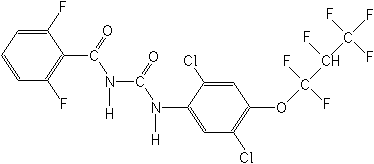|
ACTIVITY:
Insecticide (Benzoylurea)
CAS Name:
N-[[[2,5-dichloro-4-(1,1,2,3,3,3-hexafluoropropoxy)phenyl]amino]carbonyl]-2,6-difluorobenzamide
Structure:

Regulatory
Information
(only comprehensive for the US) |
| US
EPA Registered: |
Yes |
Registered
use in
(includes only a limited list of countries)
|
Australia, Hungary, India,
Japan, New Zealand, Portugal, South Africa, US, Vietnam
US
July 2003: EPA issued two Experimental Use Permits for use
as termite baits. Both permits are active for 3 years. |
| Japan's
Maximum Residue Levels (MRLs) |
Apple, Brussel Sprouts, Cabbage, Corn,
Eggplant, Grape, Grapefruit, Lemon, Lime, Loquat, Multiplying
onion (inc Shallot), Natsudaidai (whole), Orange, Other citrus
fruits, Pear, Pimento, Quince, Radish, Strawberry, Sugar beet,
Tea, Tomato, Unshu orange, Welsh (inc Leek), Yam
-
Note the very high levels - 10 ppm
- in Tea (Green, Black, Oolong, Wulung)
|
| Other
Information |
| Molecular
Formula: |
C17H8Cl2
F8 N2O3 |
| Entry
Year: |
1994 |
| Manufacturers: |
Novartis,
Syngenta |
| Other
Names: |
Axor
Match
Sorba
CGA 184699,
CG-159
Program
Sentinel (FDA approved)
100-EUP-112
100-EUP-113
|
| Manufacture
site: |
UK:
Novartis, Grimsby, NE Lincolnshire |
| Of
special interest: |
| PAN
Data |
| Lufenuron7.
Canadian Ministry report on rejection due to residues in poultry
breast meat. - Ontario Agriculture,
Food, and Rural Affairs (Canada) |
| Current
Uses in Pets: FDA registered because
it was given orally and absorbed systemically. |
| Warning
from Pet Consumer Report. |
| August,
2001 - IR-4:
New Products/Transitional
Solution List - This list contains
brief descriptions of numerous new pest control materials that
have been introduced over the last several years. Additionally,
it contains information on some "older" crop protection
chemicals that are believed to have room for new uses. This
List includes: Lufenuron
|
| Glossary
of Pesticide Chemicals, October 2001.
A listing of pesticides subject to analysis of residues in foods
and feeds by the US Food and Drug Administration. |
| Adverse
Effects:
As
of Oct 2003: No data available |
http://www.ncbi.nlm.nih.gov/entrez/query.fcgi?db=pubmed&cmd=Retrieve&dopt=AbstractPlus&list_uids=16786494&query_hl=1&itool=pubmed_docsum
Pest
Manag Sci. 2006 Aug;62(8):752-8.
Hazards
and uptake of chitin synthesis inhibitors in bumblebees
Bombus terrestris.
Mommaerts
V, Sterk G, Smagghe G.
Department
of Biology, Faculty of Sciences, Free University of Brussels,
Brussels, Belgium.
This
research project examined the potential hazards of a major
class of insect growth regulators (IGRs) to survival, reproduction
and larval growth in bumblebees Bombus terrestris L. Eight
chitin synthesis inhibitors (CSIs) were tested: buprofezin,
cyromazine, diflubenzuron, flucycloxuron,
flufenoxuron, lufenuron, novaluron
and teflubenzuron.
These different IGRs, which are important in the control
of pest insects in greenhouses, were applied via three different
routes of exposure under laboratory conditions: dermal contact,
and orally via the drinking of sugar/water and via pollen.
The compounds were tested at their respective maximum field
recommended concentrations (MFRC) and also in dose-response
assays to calculate LC(50) values. In general, none of the
CSIs showed acute worker toxicity. However,
there was a dramatic reduction in brood production, especially
after oral treatment with pollen and sugar/water.
Conspicuously, egg fertility was reduced
in all treatments with diflubenzuron and teflubenzuron.
In addition to egg mortality, the worker bumblebees
removed larvae from the treated nest, and in most cases
these individuals were dead first-second instars. Under
a binocular microscope, such larvae showed an abnormally
formed cuticle leading to mechanical weakness and death.
In another series of experiments using (14)C-diflubenzuron
and (14)C-flufenoxuron, cuticular penetration in workers
was studied for a better understanding of the differences
in toxicity. With (14)C-diflubenzuron, transovarial transport
and accumulation in the deposited eggs supported the strong
reproductive effects. Overall, the
present results suggest that CSIs should be applied with
caution in combination with bumblebees. The compatibility
of each compound to be used in combination with B. terrestris
is discussed in relation to calculated LC(50) values, routes
of uptake and effects.
PMID:
16786494 [PubMed - indexed for MEDLINE]
NOTE
from FAN: 6 of the 8 pesticides tested
are fluorinated: diflubenzuron, flucycloxuron, flufenoxuron,
lufenuron, novaluron and teflubenzuron
|
| US
Federal Register |
| Date
Published |
Docket
Identification Number |
Details |
| July
18, 2003 |
OPP-2003-0197 |
SYNGENTA
-Issuance
of Experimental Use Permit: 100-EUP-112.
to Syngenta Crop Protection, 410 Swing Road, Greensboro, NC
27419-8300. This EUP allows the use of 74 pounds active ingredient
of the insecticide Lufenuron around
125 structures to be used as an outdoor
in-ground termite bait. The program is authorized in
the States of Alabama, Arizona, Arkansas, California, Florida,
Georgia, Hawaii, Indiana, Kansas, Kentucky, Louisiana, Maryland,
Mississippi, Missouri, Nebraska, Nevada, North Carolina, Ohio,
Oklahoma, Pennsylvania, South Carolina, Texas, and Virginia.
The EUP is effective from April 3, 2003 to April 3, 2006. |
| July
18, 2003 |
OPP-2003-0197 |
SYNGENTA
-Issuance of Experimental
Use Permit: 100-EUP-113
to Syngenta Crop Protection, 410 Swing Road, Greensboro, NC
27419-8300. This EUP allows the use of 1 pound active ingredient
of the insecticide Lufenuron around
25 structures to be used as an above ground
termite bait. The program is authorized only in the States
of Arizona, California, Florida, Georgia, Hawaii, Louisiana,
Ohio, South Carolina, and Texas. The EUP is effective from May
7, 2003 to May 7, 2006. |
| Oct
2, 1998 |
HFA-305 |
NOVARTIS
- Oral
Dosage Form New Animal Drugs; Lufenuron Tablets.
FINAL RULE. The Food and Drug Administration is amending
the animal drug regulations to reflect approval of a supplemental
new animal drug application (NADA) filed by Novartis Animal
Health US, Inc. The supplemental NADA provides for revising
the specifications and conditions of use of lufenuron
tablets for dogs and cats for control of flea populations. |
|